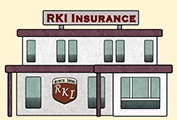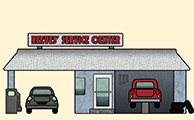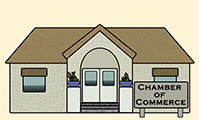Terms and Definitions
Terms and Definitions for Auto Insurance
A
Accident Prevention: Defensive Driving classes that may make 55 year and older drivers elligible for insurance discounts.
Alternate Garage: A garage location other than the insured's residence where a vehicle is principally located.
Anti-Theft: Active System: An Anti-Theft system that has to be manually armed with a switch or a button. Includes mechanical devices that must be set such as steering wheel locks.
Anti-Theft: Alarm: An Anti-Theft system that discourages theft with loud noises. May also incorporate flashing lights.
Anti-Theft: Passive System: An Anti-Theft system that automatically arms itself.
At-Fault: An accident/occurence or loss that you were responsible for.
Auto Loan Lease: Coverage that repays a loan/lease/lien on your vehicle in the event of a total loss. Loan/lease/lien must be held by a financial institution and not an individual.
Auto Seat Belts: Seat belts that automatically move into postition when the door is closed.
A/V Coverage: Coverage to replace non-factory audio or visual equipment permanently installed in your vehicle.See Also: Custom Equipment
B
Bodily Injury: Bodily harm, sickness, or disease, including death.
C
Collision: Covers losses resulting from impact with another vehicle or object or the overturn of the vehicle. Only covers damage to the vehicle itself. See Also: Comprehensive
Combined Single Limit:The total amount available to cover losses from a single occurence. Does not have per person or property damage sub-limits. See Also: Split Limits
Comprehensive: Coverage against physical damage from all causes except those covered by collision. See Also: Collision
Continuous Coverage: Length of time with insurance coverage without cancels or lapses.
Cost New: The value of replacing your vehicle with a comparable brand new vehicle.
Custom Equipment: Non-factory issue equipment permanently attached to your vehicle.
D
Deductible: An amount that the insured must pay before the insurer will begin covering the loss. Deductible are usually applicable for each occurence.
Distant Student: A discount available for students that are covered under the policy but are away at college. Typically over 1,000 miles away without a car but each carrier has their own definitions.
Drive Other Car: Provides similar coverages to Personal Auto Policies when driving a non-owned vehicle such as a company-provided car.See Also: Non-Owned
E
Electronic Stability Control: Vehicle software that reduces skidding by using brakes to assist in steering or by reducing engine output.
F
First Named Insured: The primary policy holder that has full control and obligations in the policy.
G
Glass Coverage: Allows replacement of Glass wihtout having to pay a deductible.
Good Student: Discount available to students who meet GPA requirements as defined by the carrier.
L
Lapse: A termination of a policy due to non-payment of premiums.
Lien: A legal claim or financial interest in property of another, usually resulting from a loan.
M
Mass Transit Pass: A monthly or yearly public transportation pass such as a bus or subway pass.
N
Named Insured: A person or organization specifically named in the policy.
Named Operator: A policy that covers a specific driver on any vehicle.See Also: SR-22
No-Fault: Coverage that applies regardless of fault. See Also: Personal Injury Protection
Non-Owned: A car primarily used by the driver that isn't owned, leased, hired, rented, or borrowed. Typically a company owned car issued to an employee. See Also: Drive Other Car
O
Occurence: An accident, including continuous or repeated exposure to harmful conditions.
Original Parts: Coverage that guarantees repairs will be made with original manufacturer parts.
P
Principle Driver: The primary or main driver of a vehicle.
Property Damage: Physical damage to the tangible property resulting in loss of use.
Personal Injury Protection: Benefits for medical expenses, loss of income, funeral expenses, and similar coverages regardless of fault.See Also: No-Fault.
R
Rental: Provides a daily amount to cover the cost to rent a car.
Removable Media: Coverage that pays for the loss of CD's, tapes, MP3's, and other media that can be taken from the car.
S
Split Limits: Limits that are specific to per person, per occurence, and property damage per occurence. Typically listed as 25/50/10 meaning $25K per person, $50K per occurence, and $10K property damage per occurence. See Also: Combined Single Limit
SR-22: Also called a Financial Responsibility Filing, this proves to the state that you have auto insurance. See Also: Named Operator
Stated Amount: A value for your vehicle that you provide to determine coverage.
T
Tow: An amount of coverage to pay or reimburse the cost to tow your vehicle
Trip Interruption: Coverage that cost of forfeited expenses or incurred costs when a trip or vacation is interrupted.
U
Under Insured Motorist: When another driver causes you a loss and his limits are less than the value of the loss, this coverage kicks in to cover the loss until limits are exhausted.
Uninsured Motorist: Coverage that protects you from a loss when an uninsured motorist causes a loss.
V
Violation: A traffic ticket.
Terms and Definitions for Homeowners Insurance
A
Actual Cash Value: The cost to replace your home with new materials minus depreciation.
B
Basic Peril: The lowest level of Homeowners peril coverage. Covers: Wind, Hail, Aircraft, Riot, Vehicles, Vandalism, Explosion, Smoke (Remember WHARVVES), Fire, and Theft. *Companies may differ*
Bodily Injury: Bodily harm, sickness, or disease, including death.
Broad Peril: Basic peril coverage plus Breakage of Glass, Collapse of Building, Weight of Snow/Ice/Sleet, Freezing of plumbing/Heating/AC systems and Domestic Appliances, Falling Objects, Accidental discharge/leakage/overflow of water or steam from plumbing/heating/AC systems, Sudden/Accidental Tearing/Cracking/Bulging of a steam or hot water heater. *Companies may differ*
C
Co-Insurance: The minimum limit you can have your house insured for without penalty, typically 80%. So you would have to have your home insured for at least 80% of what its true replacement cost is or you would incur a penalty. The penalty is a loss of coverage determined by dividing the insurance you did have by the insurance you should have had. Remember Did Over Should.
Coverage A: Dwelling - The limit of insurance to cover a loss to the primary dwelling and physically attached structures such as an attached garage. *Companies may differ*
Coverage B: Other Structures - The limit of insurance to cover losses to any structures not physically attached to the primary dwelling. *Companies may differ*
Coverage C: Personal Property - The contents of your home and other structures.
Coverage D: Loss of Use - The cost of additional living expenses to maintain a normal standard of living when the dwelling becomes uninhabitable due to a covered loss.
Coverage E: Personal Liability - Provides coverage for Bodily Injury and Property Damage for which a covered person is liable for.
Coverage F: Medical Payments to Others - Provides coverage for medical expenses incurred by others because of a covered loss.
D
Deductible: An amount that the insured must pay before the insurer will begin covering the loss. Deductible are usually applicable for each occurence.
E
Endorsement: A change in the policy. Can be used to add, extend, reduce, or delete coverages or exclusions.
L
Lien: A legal claim or financial interest in property of another, usually resulting from a loan.
O
Open Peril: The best peril coverage, worth the extra cost. Covers ALL loses except those caused by: Flood, Earthquake, War, Nuclear Accident. *Companies may differ*
Occupancy: The frequency you are at the house (Primary, Secondary, Seasonal, Vacant)
P
Peril: The cause of a loss.
Protection Class: A risk rating developed by ISO. Basically, it's how fast emergency services can respond to a call at your house.
R
Replacement Cost: The cost to replace your home with new materials. Keep in mind that this means the amount of money it will cost for your insurance carrier to build the house. Carriers must use specific contractors to ensure a quality job, and it usually costs significantly more than you could replace your house for.
S
Scheduled Items: Items that are valuable enough that you want specific limits just for them.
U
Usage: The way you use the house (residence, rental, vacation home).
RKI Insurance | Website Development by EZLynx® • Copyright © . All Rights Reserved.
 Welcome to the Neighborhood
Welcome to the Neighborhood  The Service Center
The Service Center Chamber of Commerce
Chamber of Commerce